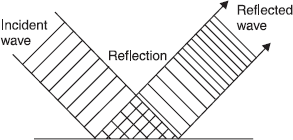REFLECTION OF WAVES
When a wave meets a surface separating two materials in which its velocity is different, some of the energy of the wave is reflected. The reflected wave has the same velocity, frequency and wavelength as the incident wave and the two waves are symmetrical with the surface, Fig. 1.14.
In some cases of reflection, a change of phase occurs which is of importance when considering the details of sound and light waves. In external reflection, the phase of a wave changes by 180°. In the case of internal reflection, the incident and reflected waves are in phase. This is shown in Fig. 1.15.

Fig. 1.14 The reflected wave and the ...
Get Consumer Electronics now with the O’Reilly learning platform.
O’Reilly members experience books, live events, courses curated by job role, and more from O’Reilly and nearly 200 top publishers.

